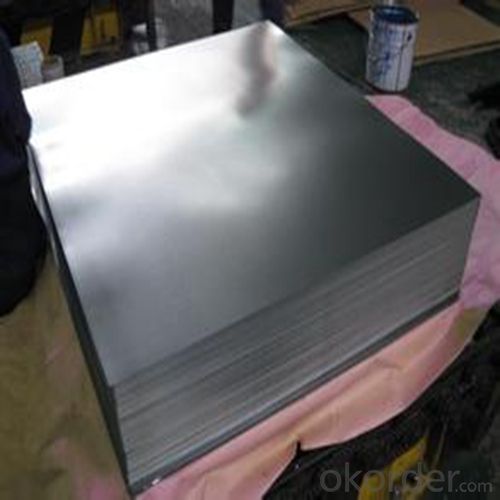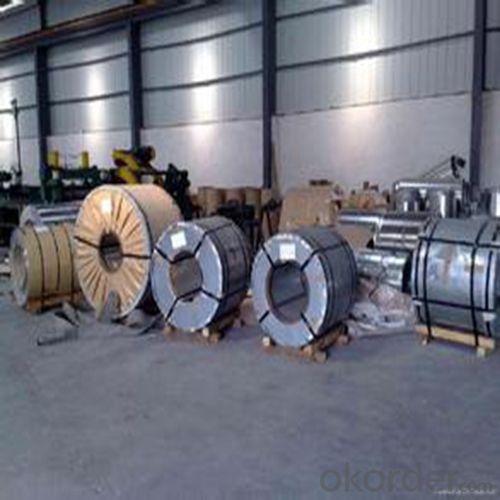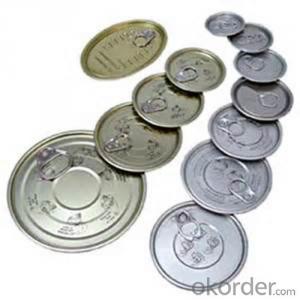Prime Quality Electrolytic Tinplate and TFS for Metal Containers
- Loading Port:
- Shanghai
- Payment Terms:
- TT OR LC
- Min Order Qty:
- 50 m.t.
- Supply Capability:
- 25000 m.t./month
OKorder Service Pledge
OKorder Financial Service
You Might Also Like
Item specifice
1.Structure of Prime Quality Electrolytic Tinplate and TFS for Metal Containers Description
Also known as chromed steel, tin-free steel (TFS) is obtained by coating the metal base (low-carbon steel) with an ultra-thin layer of metallic chrome and then with a chromium oxide layer.
The product complies with ASTM A-657 Specification and is manufactured with low current density (TFS-III) and is supplied in coils (up to 12 metric tons)or sheets.
2.Main Features of the Prime Quality Electrolytic Tinplate and TFS for Metal Containers
Corrosion resistance – Tinplate has got good corrosion resistance. By selecting a proper coating weight, appropriate corrosion resistance is obtained against container contents. Coated items should meet 24 hour 5 % salt spray requirement.
Solderability and weldability – Tinplates can be joined both by soldering or welding. These properties of tinplate are used for making various types of cans.
Hygienic – Tin coating provides good and non toxic barrier properties to protect food products from impurities, bacteria, moisture, light and odours.
Safe – Tinplate being low weight and high strength makes food cans easy to ship and transport.
Eco friendly – Tinplate offers 100 % recyclability.
Tin is not good for low temperature applications since it changes structure and loses adhesion when exposed to temperatures below – 40 deg C.
3.Prime Quality Electrolytic Tinplate and TFS for Metal Containers Images



4.Prime Quality Electrolytic Tinplate and TFS for Metal Containers Specification
Specification of :
Standard: ISO 11949 -1995, GB/T2520-2000,JIS G3303,ASTM A623, BS EN 10202
Material: MR,SPCC
Thickness:0.15mm - 0.50mm
Width: 600mm -1150mm
Temper: T1-T5
Annealing: BA & CA
Coil Inner Diameter: 508mm
Weight: 6-10 tons/coil 1~1.7 tons/sheets bundle
Passivation:311
Oil: DOS
Surface: Finish,bright,stone,matte,silver
5.FAQ of Prime Quality Electrolytic Tinplate and TFS for Metal Containers
- How are the tinplates specified?
The tinplates are specified as per the steel base, extent of tempering, the coating weight, annealing method and the surface finish.
- How many types there are for base steels?
The base steels are of three types: Type MR, L, D
- Q:What are the challenges faced in the recycling of tinplate?
- One of the main challenges in the recycling of tinplate is the separation of tin from steel. Tin is a valuable material and it is important to recover it efficiently. However, the process of separating tin from steel can be complicated and time-consuming. Additionally, the presence of other contaminants in tinplate, such as paint or other coatings, can further complicate the recycling process. Another challenge is the collection and sorting of tinplate waste, as it often ends up mixed with other materials in the general waste stream. This makes it harder to recover and recycle tinplate efficiently. Overall, the challenges in the recycling of tinplate involve the efficient separation of tin from steel and the collection and sorting of tinplate waste.
- Q:How does tinplate perform in terms of corrosion resistance?
- Tinplate performs exceptionally well in terms of corrosion resistance due to the presence of a thin layer of tin on its surface. This tin coating acts as a barrier, protecting the underlying steel from corrosion, making tinplate highly resistant to rust and other forms of corrosion.
- Q:How is tinplate coated with metallic coatings?
- Tinplate is coated with metallic coatings through a process called electroplating, where a layer of metal is deposited onto the tinplate surface using an electrolytic bath. This bath contains ions of the desired coating metal, which are attracted to the tinplate and form a thin and uniform layer through the application of an electric current. This electroplating process helps to enhance the durability, corrosion resistance, and aesthetic appearance of the tinplate.
- Q:How does tinplate perform in terms of light blocking properties?
- Tinplate has excellent light blocking properties due to its opaque nature, making it an effective material for preserving the quality and freshness of light-sensitive products.
- Q:What are the different ways to label tinplate closures?
- There are several different ways to label tinplate closures. One common method is using pressure-sensitive labels that can be applied directly onto the closure. Another option is to use direct printing techniques such as screen printing or pad printing to add the required information onto the closure. Additionally, some closures may be embossed or debossed with branding or text, providing a more permanent labeling solution.
- Q:What about tin cans?
- When the coating is damaged and the surrounding water, oxygen and other primary cell. Zinc is the anode oxidized tin iron is positive, do not participate in the reaction is protected by zinc than iron. Lively, active metal is negative.
- Q:How does tinplate contribute to the freshness of pet food?
- Tinplate contributes to the freshness of pet food by providing a protective barrier against oxygen, moisture, and light. This helps to prevent spoilage and maintain the quality of the food, ensuring it stays fresh for a longer period of time.
- Q:How is tinplate coated with epoxy resin?
- Tinplate is coated with epoxy resin through a process known as electrostatic spraying or roller coating.
- Q:How does tinplate affect the environment?
- Tinplate can have both positive and negative impacts on the environment. On one hand, tinplate is a highly recyclable material, which helps reduce the demand for new raw materials and decreases waste generation. Additionally, tinplate is often used as a protective coating on steel cans, preventing corrosion and extending their lifespan. This contributes to reducing the need for frequent replacements and conserving resources. However, the production of tinplate involves mining and refining tin ore, which can lead to habitat destruction, soil erosion, and water pollution if not managed properly. Furthermore, the manufacturing process may emit greenhouse gases and other air pollutants. Overall, the impact of tinplate on the environment depends on various factors, including its lifecycle management and the efficiency of recycling processes.
- Q:How does tinplate packaging contribute to product protection against leakage?
- Tinplate packaging contributes to product protection against leakage primarily due to its durable and corrosion-resistant properties. The tin coating on the steel substrate prevents any contact between the product and the surrounding environment, minimizing the risk of leakage. Additionally, tinplate packaging is often manufactured using advanced sealing techniques, ensuring airtight and leak-proof closures. Overall, the robust nature of tinplate packaging serves as a reliable barrier, safeguarding the product from potential leakage and preserving its quality.
1. Manufacturer Overview |
|
|---|---|
| Location | |
| Year Established | |
| Annual Output Value | |
| Main Markets | |
| Company Certifications | |
2. Manufacturer Certificates |
|
|---|---|
| a) Certification Name | |
| Range | |
| Reference | |
| Validity Period | |
3. Manufacturer Capability |
|
|---|---|
| a)Trade Capacity | |
| Nearest Port | |
| Export Percentage | |
| No.of Employees in Trade Department | |
| Language Spoken: | |
| b)Factory Information | |
| Factory Size: | |
| No. of Production Lines | |
| Contract Manufacturing | |
| Product Price Range | |
Send your message to us
Prime Quality Electrolytic Tinplate and TFS for Metal Containers
- Loading Port:
- Shanghai
- Payment Terms:
- TT OR LC
- Min Order Qty:
- 50 m.t.
- Supply Capability:
- 25000 m.t./month
OKorder Service Pledge
OKorder Financial Service
Similar products
New products
Hot products
Hot Searches
Related keywords


























